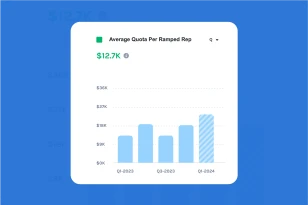What is Sales Headcount as a % of Total Headcount?
Sales Headcount as a % of Total Headcount measures the proportion of employees dedicated to sales roles relative to the entire workforce. It indicates the significance of the sales function within the organization.
Why is it important to monitor Sales Headcount as a % of Total Headcount?
Sales Headcount as a % of Total Headcount is crucial for several reasons:
- Resource Allocation: The metric provides insights into how resources are allocated within the organization. A higher percentage suggests a strong emphasis on sales, reflecting the strategic importance of revenue generation in the company’s overall objectives.
- Strategic Alignment: It reflects the company’s strategic priorities. A higher percentage indicates a focus on driving revenue through sales efforts, aligning the workforce with business goals, and emphasizing the importance of sales in the company’s growth strategy.
- Efficiency and Productivity: Monitoring the ratio helps evaluate the efficiency and productivity of the sales team. A well-balanced ratio ensures that the sales team is appropriately sized to handle the volume of leads and opportunities, optimizing the use of human capital.
- Investor Perception: Investors often assess the Sales Headcount as a % of Total Headcount as an indicator of a company’s growth potential and emphasis on revenue generation. A balanced ratio contributes to positive investor perception.
How do you calculate Sales Headcount as a % of Total Headcount?
Sales Headcount as a % of Total Headcount Formula
(# of Sales Employees/Total Number of Employees) * 100
How do you improve Sales Headcount as a % of Total Headcount?
Improving Sales Headcount as a % of Total Headcount involves strategies to enhance the effectiveness of the sales function and optimize overall workforce composition. Here are some approaches to improve this metric:
- Sales Efficiency Analysis: Conduct a comprehensive analysis of sales efficiency by evaluating key performance indicators such as conversion rates, deal sizes, and sales cycle duration. Identify areas for improvement to ensure that the existing sales team operates at peak efficiency.
- Training and Skill Development: Invest in training programs to enhance the skills of the existing sales team. Focus on improving product knowledge, sales techniques, and customer relationship management skills to increase the team’s effectiveness.
- Technology Integration: Implement advanced sales technologies and automation tools to streamline processes and increase the productivity of the sales team. Automation can reduce manual tasks, allowing the team to handle a larger volume of leads without proportionally increasing headcount.
- Lead Qualification and Nurturing: Implement robust lead qualification processes to ensure that the sales team focuses on high-potential leads. Additionally, invest in lead nurturing strategies to move leads through the sales funnel more efficiently, reducing the need for additional headcount.
- Incentive Structures: Review and optimize incentive structures to motivate the existing sales team. Well-designed incentive programs can boost morale, encourage high performance, and contribute to achieving sales targets without expanding the team size.
- Customer Retention Strategies: Prioritize customer retention efforts to ensure ongoing revenue from existing clients. Satisfied and loyal customers contribute to a stable revenue stream, reducing the pressure to continually expand the sales team to acquire new customers.
- Market Expansion Strategies: Explore opportunities for market expansion and diversification. Identify new customer segments or geographical markets that align with the company’s offerings, allowing for revenue growth without a proportional increase in sales headcount.
- Data-Driven Decision-Making: Leverage data analytics to make informed decisions about sales strategies, resource allocation, and workforce composition. Analyze performance metrics and market trends to identify opportunities for optimization.





